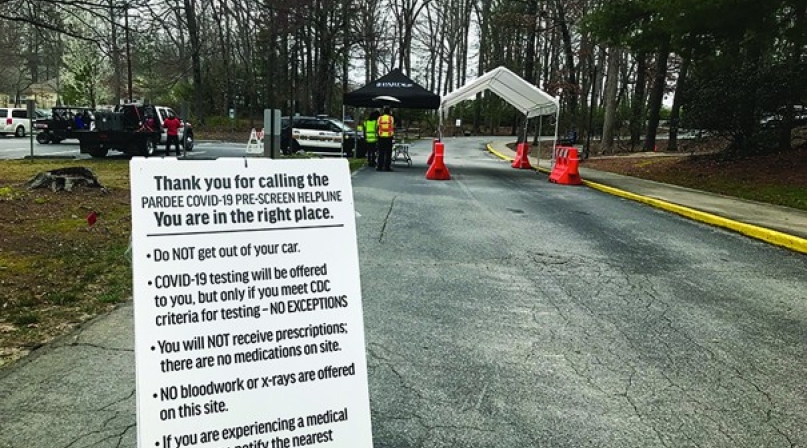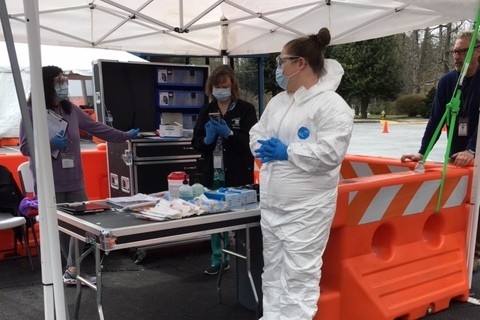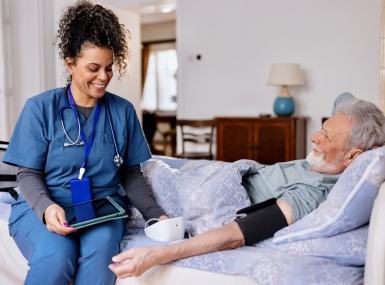Coronavirus: Counties find solutions to monitor symptoms, test for cases
Author
Upcoming Events
Related News

With capacity challenges that come with testing for the coronavirus, county officials are finding innovative solutions to safely perform COVID-19 screenings while finding ways to make communities feel safe.
Henderson County, N.C., is one of many counties that established a drive-through screening site for both the flu and COVID-19.
The offsite mobile center, established in a matter of days, is in partnership with Pardee Hospital — University of North Carolina Health, the Henderson County Department of Public Health, Henderson County emergency management, emergency services, EMS rescue squad, Henderson County sheriff’s department and the Blue Ridge Community College.
Patients must be referred to the drive-through site by calling a phone line and completing a screening over the phone with a medical professional who notifies the testing center when to expect patients, according to Henderson County Manager Steve Wyatt. The screening is free for all Henderson County residents.
Patients drive through a series of screening stations including a checkpoint established by the sheriff’s department.
Pardee hospital nurses, who are under the supervision of physicians, staff the testing center. All medical professionals wear personal protective equipment.
At the first stop, patients are screened by a physician who asks more detailed questions. Then, nurses test all patients for the common flu. The results take five to 10 minutes and individuals wait in their vehicles in a parking lot.
“You are in your car,” Wyatt said. “You are driving. You never get out of your car.”
If someone tests positive for the flu, they receive instructions and may receive a prescription for an antibiotic. If they test negative for the flu, they drive to another tent operated by the Henderson County Public Health Department where they are tested for COVID-19 and given instructions to self-quarantine.
“It’s easy, quick, it’s painless, it’s no charge,” Wyatt said. “We’re able to process a lot of folks quickly without exposing others.”
The test results take a few days to get back to the health department.
“If you’re given the COVID-19 test, we check on you every day, see how you’re doing,” he said. “Once you get the results, you’re counseled and depending on your condition referred to a hospital, but more than likely you’re quarantined.”
The county is using test kits from LabCorp, a testing laboratories company in North Carolina. Wyatt said completed tests are sent to the company, which has a contractual relationship with the county.
“We’re trying to slow the progression of this disease, so it won’t overwhelm our local health care capabilities,” he said.
For Henderson County, Wyatt said as of March 18, running out of testing kits is not a primary concern.
“We have a stock and we’re using them, but they’re meant to be used,” he said. “I’ve been given no indication by our medical staff that we’re in danger of running out.”
The site opened in the afternoon on March 15 and 29 patients came through the drive-through center. Around 70 patients were tested the following two days.
“We have had a steady stream of patients, but we have not been overwhelmed,” he said.
As of March 19, there were no confirmed cases of coronavirus in Henderson County.
“We’re able to do mass testing basically, testing on a large scale with minimizing the exposure to others,” he said. “We’re keeping people out of the ERs, keeping people out of urgent cares, out of doctor’s offices.”
The site is located behind the Blue Ridge Community College campus, which is closed along with all other community colleges in the state. Wyatt said this provides abundant parking options and allows staff to use facilities on campus.
“Your elected officials have got to understand that time is of the essence,” he said. “We don’t know what tomorrow will bring, but I’ll tell you there’s no time to wait because the more you wait, the more in danger you put your local healthcare capacity.”
Counties turn to self-reporting
In Eagle County, Colo., Epidemiologist and Deputy Public Health Director Rebecca Larson said with limitations on testing supplies, lab capacity and personal protective equipment, not everyone who has symptoms in the county is able to be tested for the coronavirus.
The county, which as of March 18 had 55 cases, turned to a self-monitoring form that serves as a tool to measure the rate of illness in communities. As of March 19, the form has received nearly 500 responses.
Learn More
For more information on the self-reporting form, contact Brandon Williams or Kathy Chandler-Henry.
County residents can complete a Google form online or on a mobile device that asks if the user has pre-existing medical conditions or if they have compromised immune systems. Then, the user checks off their symptoms and adds the date when their symptoms started. County residents can submit their contact information or complete the form anonymously.
“We still need to understand the level of illness in our community, the amount of spread of the illness and also evaluate whether the strategies we put in place such as social distancing are effective in reducing that spread,” Larson said.
The submissions from the form are tracked on a webpage that shows live data through graphs that are divided into age groups, towns within the county and number of reported symptoms.
Larson said the county is facing challenges with limitations on personal protective equipment for healthcare workers to be able to safely perform tests. Additionally, there is an overwhelming number of specimens being sent to both commercial and state labs.
According to Larson, the county follows up with individuals who report having higher risk factors to ensure they are connected to testing and have information about the coronavirus.
“Having something that a community can pay attention to and look at and then on the public health/epi-side for us, early detection and early response, are vital to preventing the spread of this virus,” she said.
Director of Innovation and Strategy Brandon Williams said when it comes to “flattening the curve” in the absence of testing, it’s hard to tell what the curve is without data.
“I think we’ve got a fighting chance of actually having a better graph of that curve that hopefully will help public health responders and incident commanders get resources and really start planning for the recovery of this,” he said.
The self-monitoring form was designed to be simple and completed easily. The form is created using Google’s G-Suite platform, according to Williams.
“It was just sitting down and creating a user-friendly form so people can self-report but also feel like they were being heard and contribute to the response,” he said.
For other counties and communities throughout the country, Williams said there’s no reason to not create a self-monitoring form.
“The upsides are letting the community know that we’re all in this and they can see if the social distancing they’re practicing is working by watching what’s happening here,” Chair of the Eagle County Board of Commissioners Kathy Chandler-Henry said.
She added that the form helps bring a sense of calmness to the community.
“People just have a thirst for information that isn’t coming very quickly from official channels. This is really quick, it gives them a sense of control, it gives them a sense that the county has a handle of what’s going on in the community and because of this tool, we do,” she said.
The county created the form as a template that can be easily replicated by other county governments.
“We really hope that that helps others get a better picture on what’s happening in their communities,” Williams said.

Attachments
Related News

Join NACo in celebrating County Health Day on April 19, 2024
County Health Day, which falls during National County Government Month, celebrates the pivotal role counties play in promoting public health and building resilient communities.

FCC takes critical steps to improve the 988 National Suicide Lifeline
On March 21, bipartisan congressional leaders and FCC Chairwoman Jessica Rosenworcel announced steps to improve the 988 National Suicide Lifeline. This announcement marks major progress on the nation’s crisis response, a priority for counties and a key policy pillar of the NACo Commission on Mental Health and Wellbeing.

House Ways and Means Committee passes bill blocking proposed CMS nursing home minimal staffing rule
On March 5, the U.S. House of Representatives Committee on Ways and Means marked up and reported out of committee the Protect America’s Senior’s Access to Care Act (H.R. 7513).
